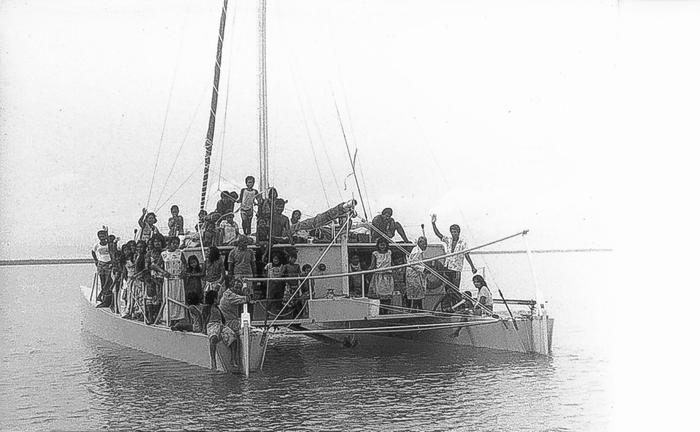Aloha Friend
This is why we’re really building boats. You’ll need to make pictures of this in your head, because we don’t have any yet. But it will look similar to the “Lagoon Bus” in the photo below, which I built in 1985 for the people of Kiribati.

Miguel, Eliza, and their three kids, plus Eliza’s father Marco, all need to go from Punta Arenas, Costa Rica (where they live) to Pochote for the christening of Marco’s grandchild Enrique. Enrique is Eliza’s brother Pablo’s first child, so it’s a real occasion.
It’s 200 kilometers by road, and it’s the wet season, which means breakdowns and vehicle problems. Their vehicle problem is that they don’t have a vehicle; they’re too poor to own a car. They could take the bus, if it doesn’t break down or get mud-bogged and stuck, but it’s still a two-day trip and costs 6,000 Colons for each person.
But they have managed to scrape together the 4,000 Colons for each adult, plus the 1,500 Colons each for the children, for the Island Taxi round-trip sailboat service from Punta Arenas to Pochote. While it’s 200 kilometers to Pochote by road, it’s only 41 km by boat. Marco is bringing a couple of fishing lines, so they may be able to catch some dorado or peto on the way to take to the christening party. So for only the equivalent of $28 US, they can get there, and catch some food too, if Marco’s fishing lines are lucky.
They go down to the Punta Arenas Island Taxi dock, and pick the yellow-and-turquoise, 9-meter long Taxi number 27 out of the lineup because they like its cheerful colors; her mast is painted in stripes of the same turquoise and yellow too! Although there are 50 sailing Island Taxis based in Punta Arenas, there are currently only eight boats sitting at the dock waiting for fares. This service has become so popular that during holidays and festivals, when a lot of people are traveling, you have to send someone to the dock to pay in advance if you want to reserve your Island Taxi.
They pay the attendant their money, put their baggage on the boat, the attendant checks the weather forecast, then programs the trip into the onboard computer of number 27. This is simple; he just hits a couple of buttons in the booking app on his iPhone. He makes sure they have their life jackets on, shows them how to work the simple radio to communicate with him if there’s a problem (VHF with a masthead antenna and a 50-mile range), hits another button on his iPhone to have the boat’s robot brain, servo drives and motors raise the boat’s sails, and shoves them off the dock into the rising morning breeze.
Away they go! The Island Taxi adjusts its sails, sets a course and initial heading, and sails itself to its destination by the most efficient route, its computer taking note of local winds from its weather service, utilizing its collision avoidance suite for dodging other boats, floating logs, and so on. It sails just as an experienced human sailor would, because its computer was programmed by an experienced human sailor.
The attendant goes back inside his little shack, where the GPS tracking program for the Taxis shows the numbers and locations of all the boats in Costa Rica on his 46-inch flat-screen HDTV. He’s got a spare Island Taxi at his dock, and he is a trained sailor, so if there’s a problem with any of the Taxis, he simply sails to the location, anchors the problem Taxi for pickup by the maintenance boys, and takes the passengers from the broke-down Taxi onto his Taxi, then to their destination.
The GPS transceivers are in an armored, inaccessible section of the boat, with their own uninterruptible power supply, so if someone ever hijacks a Taxi, it will squawk its location along the way to the thieve’s destination. The thieves know about this feature, and generally leave Taxis alone because of it.
Taxi 27 sails them down the bay and around the point to Pochote, where they embark at the Island Taxi dock there. and attend the christening. How easy!
Because Pochote does not rate a full-time attendant, and because the Punta Arenas attendant has checked the booking requests and sees none coming from Pochote for the next 24 hours, he has the Taxi say to the little family (in Spanish, of course) “Now please push me away from the dock; I have other people to pick up”. They do so, Taxi 27 glides off, totally unmanned, to Playa Herradura, to pick up some American tourists whose hired transportation broke an axle. And so on.
For longer trips, say Punta Arenas to Samara or Tamarindo, there is a weekly service of a 15-meter version of the Island Taxi, called the Island Bus. The Bus can carry up to 25 passengers plus baggage, and sails with a single experienced seaman on board, although the sailing is done by the batteries, electric motors, computer, and the iPhone app.
The attendants don’t know how to sail yet? Not a problem; these are self-teaching sailboats as well as autonomous taxis and buses; they can teach the attendants to sail by talking to them just like Siri does (except in Spanish, and with a little help from our company rep).
The technology is already well-developed. It’s just that no one has implemented this application of it yet. There’s not much money in it.
With Warm Aloha, Tim, Susanne, Victor, Jack, Lucky, and Rose
